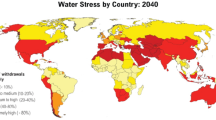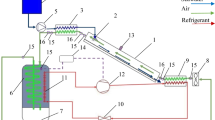Abstract
With the increasingly extensive utilization of liquefied natural gas (LNG) in China today, sustainable and effective using of LNG cold energy is becoming increasingly important. In this paper, the utilization of LNG cold energy in seawater desalination system is proposed and analyzed. In this system, the cold energy of the LNG is first transferred to a kind of refrigerant, i.e., butane, which is immiscible with water. The cold refrigerant is then directly injected into the seawater. As a result, the refrigerant droplet is continuously heated and vaporized, and in consequence some of the seawater is simultaneously frozen. The formed ice crystal contains much less salt than that in the original seawater. A simplified model of the direct-contact heat transfer in this desalination system is proposed and theoretical analyses are conducted, taking into account both energy balance and population balance. The number density distribution of two-phase bubbles, the heat transfer between the two immiscible fluids, and the temperature variation are then deduced. The influences of initial size of dispersed phase droplets, the initial temperature of continuous phase, and the volumetric heat transfer coefficient are also clarified. The calculated results are in reasonable agreement with the available experimental data of the R114/water system.
Similar content being viewed by others
References
Gu Y, Ju Y L. LNG-FPSO: Offshore LNG solution. Frontiers of Energy and Power Engineering in China, 2008, 2(3): 249–255
Gu Y, Ju Y L. Effect of parameters on performance of LNG-FPSO offloading system in offshore associated gas fields. Applied Energy, 2010, 87(11): 3393–3400
Li Q Y, Ju Y L. Design and analysis of liquefaction process for offshore associated gases. Applied Thermal Engineering, 2010, 30 (11): 2518–2525
Gao T, Lin W S, Gu A Z, Gu M. Coalbed methane liquefaction adopting a nitrogen expansion process with propane pre-cooling. Applied Energy, 2010, 87(7): 2141–2147
Li Q Y, Wang L, Ju Y L. Liquefaction and impurity separation of oxygen bearing coal-bed methane. Frontiers of Energy and Power Engineering in China, 2010, 4(3): 319–325
Maxwell D, Zhu Z. Natural gas prices, LNG transport costs, and the dynamics of LNG imports. Energy Economics, 2011, 33(2): 217–226
Xing Y, Liu M. Status quo and prospect analysis on LNG industry in China. Natural Gas Industry, 2009, 29(1): 120–123
Shi G H, Jing Y Y, Wang S L, Zhang X T. Development status of liquefied natural gas industry in China. Energy Policy, 2010, 38(11): 7457–7465
Lin W S, Zhang N, Gu A Z. LNG (liquefied natural gas): A necessary part in China’s future energy infrastructure. Energy, 2010, 35(11): 4383–4391
Zhang N, Lior N. A novel near-zero CO2 emission thermal cycle with LNG cryogenic exergy utilization. Energy, 2006, 31(10,11): 1666–1679
Cravalho E, McGrath J, Toscano W. Thermodynamic analysis of the re-gasification of LNG for the desalination of seawater. Cryogenics, 1977, 17(3): 135–139
Antonelli A. Desalinated water production at LNG-terminals. Desalination, 1983, 45(1–3): 383–390
Sideman S, Shabtai H. Shabtai, H. Direct-contact heat transfer between a single drop and an immiscible liquid medium. Canadian Journal of Chemical Engineering, 1964, 42(3): 107–117
Sideman S, Taitel Y. Direct-contact heat transfer with change of phase: Evaporation of drops in an immiscible liquid media. International Journal of Heat and Mass Transfer, 1964, 7(11): 1273–1289
Sideman S, Isenberg J, Isenberg J. Direct-contact heat transfer with change of phase: Bubble growth in three-phase systems. Desalination, 1967, 2(2): 207–214
Sideman S, Hirsch G. Direct-contact heat transfer with change of phase. III: Analysis of the transfer mechanism of drops evaporating in immiscible liquid media. Israel Journal of Technology, 1964, 2(2): 234–241
Tochitani Y, Mori Y, Komotori K. Vaporization of single liquid drops in an immiscible liquid, Part I: Forms and motions of vaporizing drops.Warme-und Stoffubertragung, 1977, 10(1): 51–59
Tochitani Y, Nakagawa T, Mori Y, Komotori K. Vaporization of single liquid drops in an immiscible liquid, Part II: Heat transfer characteristics. Warme-und Stoffubertragung, 1977, 10(2): 71–79
Raina G, Grover P. Direct contact heat transfer with change of phase: Theoretical model. AIChE Journal. American Institute of Chemical Engineers, 1982, 28(3): 515–517
Raina G, Grover P. Direct contact heat transfer with change of phase: Theoretical model incorporating sloshing effects. AIChE Journal. American Institute of Chemical Engineers, 1985, 31(3): 507–509
Raina G, Wanchoo R, Grover P. Direct contact heat transfer with phase change: Motion of evaporating droplets. AIChE Journal. American Institute of Chemical Engineers, 1984, 30(5): 835–837
Battya P, Raghavan V, Seetharamu K. Parametric studies on direct contact evaporation of a drop in an immiscible liquid. International Journal of Heat and Mass Transfer, 1984, 27(2): 263–272
Sideman S, Hirsch G, Gat Y. Direct-contact heat transfer with change of phase: Effect of the initial drop size in three-phase heat exchangers. AIChE Journal. American Institute of Chemical Engineers, 1965, 11(6): 1081–1087
Sideman S, Gat Y. Direct contact heat transfer with change of phase: Spray-column studies of a three-phase heat exchanger. AIChE Journal. American Institute of Chemical Engineers, 1966, 12(2): 296–303
Seetharamu K, Battya P. Direct contact evaporation between two immiscible liquids in a spray column. Journal of Heat Transfer, 1989, 111(1): 780–785
Mori Y. An analytic model of direct-contact heat transfer in spraycolumn evaporators. AIChE Journal. American Institute of Chemical Engineers, 1991, 37(4): 539–546
Kiatsiriroat T, Thalang K, Dabbhasuta S. Ice formation around a jet stream of refrigerant. Energy Conversion and Management, 2000, 41(3): 213–221
Kiatsiriroat T, Vithayasai S, Vorayos N, Nuntaphan A, Vorayos N. Heat transfer prediction for a direct contact ice thermal energy storage. Energy Conversion and Management, 2003, 44(4): 497–508
Byrd L, Mulligan J. A population balance approach to direct-contact secondary refrigerant freezing. AIChE Journal. American Institute of Chemical Engineers, 1986, 32(11): 1881–1888
Core K, Mulligan J. Heat transfer and population characteristics of dispersed evaporating droplets. AIChE Journal. American Institute of Chemical Engineers, 1990, 36(8): 1137–1144
Song M, Steiff A, Weinspach P. The analytical solution for a model of direct contact evaporation in spray columns. International Communications in Heat and Mass Transfer, 1996, 23(2): 263–272
Song M, Steiff A, Weinspach P. Parametric analysis of direct contact evaporation process in a bubble column. International Journal of Heat and Mass Transfer, 1998, 41(12): 1749–1758
Song M, Steiff A, Weinspach P. Direct-contact heat transfer with change of phase: A population balance model. Chemical Engineering Science, 1999, 54(17): 3861–3871
Marchal P, David R, Klein J, Villermaux J. Crystallization and precipitation engineering-I: An efficient method for solving population balance in crystallization with agglomeration. Chemical Engineering Science, 1988, 43(1): 59–67
Author information
Authors and Affiliations
Corresponding author
Rights and permissions
About this article
Cite this article
Shen, Q., Llin, W., Gu, A. et al. A simplified model of direct-contact heat transfer in desalination system utilizing LNG cold energy. Front. Energy 6, 122–128 (2012). https://doi.org/10.1007/s11708-012-0175-0
Received:
Accepted:
Published:
Issue Date:
DOI: https://doi.org/10.1007/s11708-012-0175-0




